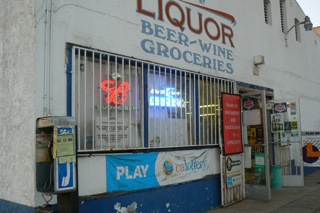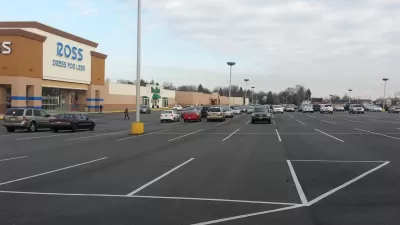Is there a happy medium between the run-down liquor store and the gourmet shop? What is the best form of Main Street retail, as people move back to the city and re-emergent neighborhoods acquire shops and services that were once lacking?
Is there a happy medium between the run-down liquor store and
the gourmet shop?
What is the best form of Main Street retail, as people move
back to the city and re-emergent neighborhoods acquire shops and services that
were once lacking?
I've lamented the disproportionate number of liquor stores in
San Diego neighborhoods that are otherwise revitalizing. Even though these shops also sell convenience
items and provide an honest living for their owners, they do little to enhance
street life. They could offer much more to their respective communities, both
in terms of product selection and storefront design. Given their centralized locations, it's a shame that
they hide from the street (the corner of Main Street, in this case):

These would not have been acceptable retail outlets to
earlier generations who relied on streetcars and walking for shopping. To reduce vehicle-miles traveled, the current generation needs easy access to a central market, at minimum.
An ideal replacement for the omnipresent liquor store is an
affordable merchant that carries fresh groceries and appeals to a diversity of
shoppers. By serving the daily
needs of residents, it could become a gathering place that activates the street
and defines the neighborhood. What sometimes appears instead is an upscale business
that screams "gentrification", a term that has come to be regarded as an undesirable flip side to blight. Such businesses, on their own, do not sufficiently rejuvenate small retail districts because they offer too limited a product
selection for an exclusive group of people. When the local store sells only hand-crafted chocolates,
residents will need daily trips to stores outside of the neighborhood.
The best retail mix is often found in cities and towns that
are well connected to a college or university - perhaps because students and
professors have a limited budget but selective tastes. Students are also more likely to not
own a car, so groceries and good restaurants need to be within walking or
biking distance. A number of
university towns boast cafes, used book stores, ethnic restaurants, grocery
stores, office supplies, pharmacies, and specialty food shops - all affordable
and all walkable from campus and residential neighborhoods.
Within these larger or established retail districts,
there is a place for everything, including liquor stores and exclusive boutiques. But on Main Street, particularly when
it's the only show in town, the central market should live up to its name.

Planetizen Federal Action Tracker
A weekly monitor of how Trump’s orders and actions are impacting planners and planning in America.

Restaurant Patios Were a Pandemic Win — Why Were They so Hard to Keep?
Social distancing requirements and changes in travel patterns prompted cities to pilot new uses for street and sidewalk space. Then it got complicated.

Map: Where Senate Republicans Want to Sell Your Public Lands
For public land advocates, the Senate Republicans’ proposal to sell millions of acres of public land in the West is “the biggest fight of their careers.”

Orange County, Florida Adopts Largest US “Sprawl Repair” Code
The ‘Orange Code’ seeks to rectify decades of sprawl-inducing, car-oriented development.

Maui's Vacation Rental Debate Turns Ugly
Verbal attacks, misinformation campaigns and fistfights plague a high-stakes debate to convert thousands of vacation rentals into long-term housing.

San Francisco Suspends Traffic Calming Amidst Record Deaths
Citing “a challenging fiscal landscape,” the city will cease the program on the heels of 42 traffic deaths, including 24 pedestrians.
Urban Design for Planners 1: Software Tools
This six-course series explores essential urban design concepts using open source software and equips planners with the tools they need to participate fully in the urban design process.
Planning for Universal Design
Learn the tools for implementing Universal Design in planning regulations.
Heyer Gruel & Associates PA
JM Goldson LLC
Custer County Colorado
City of Camden Redevelopment Agency
City of Astoria
Transportation Research & Education Center (TREC) at Portland State University
Camden Redevelopment Agency
City of Claremont
Municipality of Princeton (NJ)



























